Observing Actual Evapotranspiration within a Hilly Watershed: Case Study of the Kamech Site, Cap Bon Peninsula, Tunisia †
Abstract
:1. Introduction
2. Materials and Methods
2.1. Site Description
2.2. Experimental Design and Data Acquisition
2.2.1. Instrumental Design
2.2.2. Meteorological Station
2.2.3. Eddy Covariance Flux Tower
2.3. EC Flux Calculations and Quality Control
2.3.1. Calculating Convective Fluxes
2.3.2. Quality Control
2.4. Characterization of the Climatic Conditions
2.5. Method for Gap Filling EC Data
2.5.1. REddyProc Gap Filling Method
- Step 1: all meteorological data of interest are available (solar incoming radiation Rs, air temperature Ta, and vapor pressure deficit VPD). The missing values of H or λE are replaced by the average value under similar meteorological conditions for a given time window. Similar meteorological conditions correspond to Rs, Ta and VPD values that do not deviate by more than 50 W·m−2, 2.5 °C, 0.5 kPa, respectively. If no similar meteorological conditions are present within a 14 days time window centered on the date of interest, the time window is extended to 28 days.
- Step 2: Rs only is available. The same approach is taken, and similar meteorological conditions correspond to Rs values that does not deviate by more than 50 W·m−2. The time window is 14 days centered on the date of interest.
- Step 3: all meteorological data are missing. The missing value of H or λE are replaced by values derived at the same time of the day from a mean diurnal course (MDC). The latter are computed on the date of interest when possible, or from the two adjacent days otherwise.
2.5.2. Adapting the REddyProc Method to Hilly Cropping Systems
- First, REddyProc was applied in its original version without discriminating the two dominant wind directions (classical way). The obtained gap-filled data were labeled HREP and λEREP.
- Second, REddyProc was applied after discriminating the collected data under conditions of north-west (NW) and south (S) winds. We split the complete time series in two datasets. The NW (respectively S) dataset included the HORI and λEORI data collected under NW (respectively S) wind conditions. REddyProc was applied over each of these two datasets. The two resulting gap-filled datasets were finally merged. The obtained energy fluxes were labeled HRNS and λERNS.
3. Results and Discussion
3.1. Application of REddyProc
3.1.1. Impact of Taking into Account the Wind Direction in REddyProc
3.1.2. Gap Filling Rates Obtained
- (1)
- In May and June 2010, the LI-7500 analyser experienced a 34 days-long failure, preventing the measurement of λE. REddyProc was able to gap-fill all the missing λE data.
- (2)
- In December 2010 and January 2011, the flux tower experienced a 41 days-long failure, preventing the measurement of H and λE. REddyProc was able to gap-fill all the missing H and λE data.
- (3)
- From November 2011 to March 2012, the flux tower experienced several failures, preventing the measurement of H and λE, for 99 and 126 days, respectively. Gap-filling of missing data was only partial, leading to a 99 days long period with no gap filling for both H and λE.
- (4)
- From October 2012 to May 2013, the flux tower experienced several failures, preventing the measurement of H and λE, for 57 and 224 days, respectively. REddyProc was able to gap-fill all the missing H data, but λE data were not gap-filled during 221 days.
3.2. Seasonal Variations of Daily Surface Fluxes
3.3. Monthly Evapotranspiration
4. Conclusions
Author Contributions
Acknowledgments
Conflicts of Interest
Abbreviations
| λE | latent heat flux |
| asl | above sea level |
| EC | eddy covariance |
| EF | evaporative fraction |
| ET0 | Penman-Monteith reference evapotranspiration |
| ETa | actual evapotranspiration |
| H | sensible heat flux |
| NW | northwest wind sector (220° to 70°) |
| OMERE | french acronym for the Mediterranean Observatory of Water and Rural Environment |
| REP | REddyProc applied without discriminating wind directions (classical way) |
| RNS | REddyProc applied after discriminating wind directions (NW/S) |
| (R)RMSE | (relative) root mean squared error |
| Rs | incoming solar radiation |
| R2 | coefficient of determination |
| S | south wind sector (70° to 220°) |
| Ta | air temperature |
| VPD | water vapour pressure deficit |
References
- Besbes, M.; Chahed, J.; Hamdane, A. Sécurité Hydrique de la Tunisie (Water Security of Tunisia); Preface by G. de MARSILY; l’Harmattan: Paris, France, 2014; 354p. [Google Scholar]
- Moussa, R.; Chahinian, N.; Bocquillon, C. Distributed hydrological modelling of a Mediterranean mountainous catchment—Model construction and multi-site validation. J. Hydrol. 2007, 337, 35–51. [Google Scholar] [CrossRef]
- Steduto, P.; Hsiao, T.C.; Raes, D.; Fereres, E. AquaCrop—The FAO crop model tosimulate yield response to water: I. Concepts and underlying principles. Agron. J. 2009, 101, 426–437. [Google Scholar] [CrossRef]
- Wang, K.C.; Dickinson, R.E. A review of global terrestrial evapotranspiration: Observation, modeling, climatology, and climatic variability. Rev. Geophys. 2012, 50, RG2005. [Google Scholar] [CrossRef]
- Seneviratne, S.I.; Corti, T.; Davin, L.E.; Hirschi, M.; Jaeger, E.B.; Lehner, I.; Orlowsky, B.; Teuling, A.J. Investigating soil moisture–climate interactions in a changing climate: A review. Earth Sci. Rev. 2010, 99, 125–161. [Google Scholar] [CrossRef]
- Cai, X.; Zhang, X.; Noël, P.H.; Shafiee-Jood, M. Impacts of climate change on agricultural water management: A review. WIREs Water 2015, 2, 439–455. [Google Scholar] [CrossRef]
- Li, Q.; Ishidaira, H. Development of a biosphere hydrological model considering vegetation dynamics and its evaluation at basin scale under climate change. J. Hydrol. 2012, 412, 3–13. [Google Scholar] [CrossRef]
- Karimi, P.; Bastiaanssen, W.G.M. Spatial evapotranspiration, rainfall and land use data in water accounting—Part 1: Review of the accuracy of the remote sensing data. Hydrol. Earth Syst. Sci. 2015, 19, 507–532. [Google Scholar] [CrossRef]
- Aubinet, M.; Vesala, T.; Papale, D. Eddy Covariance—A Practical Guide to Measurement and Data Analysis; Springer Atmospheric Sciences: Dordrecht, The Netherlands, 2012; p. 438. [Google Scholar] [CrossRef]
- Alavi, N.; Warland, J.S.; Berg, A.A. Filling gaps in evapotranspiration measurements for water budgetstudies: Evaluation of a Kalman filtering approach. Agric. For. Meteorol. 2006, 141, 57–66. [Google Scholar] [CrossRef]
- Falge, E.; Baldocchi, D.D.; Olson, R.; Anthoni, P.; Aubinet, M.; Bernhofer, C.; Burba, G.; Ceulemans, R.; Clement, R.; Dolman, H.; et al. Gap filling strategies for long term energy flux data sets. Agric. For. Meteorol. 2001, 107, 71–77. [Google Scholar] [CrossRef]
- Greco, S.; Baldocchi, D.D. Seasonal variations of CO2 water vapour exchange rates over a temperate deciduous forest. Glob. Chang. Biol. 1996, 2, 183–197. [Google Scholar] [CrossRef]
- Berbigier, P.; Bonnefond, J.M.; Mellmann, P. CO2 and water vapour fluxes for 2 years obove Euroflux forest site. Agric. For. Meteorol. 2001, 108, 183–197. [Google Scholar] [CrossRef]
- Wilson, K.B.; Baldocchi, D.D. Seasonal and interannual variability of energy fluxes over a broadleaved temperate deciduous forest in North America. Agric. For. Meteorol. 2000, 100, 1–18. [Google Scholar] [CrossRef]
- Wilson, K.B.; Hanson, P.J.; Mulholland, P.J.; Baldocchi, D.D.; Wullschleger, S.D. A comparison of methods for determining forest evapotranspiration and its components: Sap-flow, soil water budget, eddy covariance and catchment water balance. Agric. For. Meteorol. 2001, 106, 153–168. [Google Scholar] [CrossRef]
- Hui, D.; Wan, S.; Su, B.; Katul, G.; Monson, R.; Luo, Y. Gap filling missing data in eddy covariance measurements using multiple imputation (MI) for annual estimations. Agric. For. Meteorol. 2004, 121, 93–111. [Google Scholar] [CrossRef]
- Mekki, I.; Albergel, J.; Ben Mechlia, N.; Voltz, M. Assessment of overland flow variation and blue water production in a farmed semiarid water harvesting catchment. Phys. Chem. Earth 2006, 31, 10481061. [Google Scholar] [CrossRef]
- Ameur, M.; Mtimet, N.; Khlifi, S. Effects of Small Hill Dams on Farming Systems: Bizerte Region. In Tunisia Semi-Arid Environments: Agriculture, Water Supply and Vegetation; Degenovine, K.M., Ed.; Nova Science Pulishers: Hauppauge NY, USA, 2011; pp. 159–172. [Google Scholar]
- Joodi, N.; Satyanarayana, S.V. Design of Check Dam for Effective Utilization of the Aflaj Water Resources. Int. J. Multidiscip. Res. Dev. 2015, 2, 446–449. [Google Scholar]
- Parimala Renganayaki, S.; Elango, L. A review on managed aquifer recharge by check dams: A case study Near Chennai, INDIA. Int. J. Res. Eng. Technol. 2013, 2, 416–423. [Google Scholar]
- Zitouna-Chebbi, R.; Prévot, L.; Jacob, F.; Mougou, M.; Voltz, M. Assessing the consistency of eddy covariance measurements under conditions of sloping topography within a hilly agricultural catchment. Agric. For. Meteorol. 2012, 16, 123–135. [Google Scholar] [CrossRef]
- Zitouna-Chebbi, R.; Prévot, L.; Jacob, F.; Voltz, M. Accounting for vegetation height and wind direction to correct eddy covariance measurements of energy fluxes over hilly crop fields. J. Geophys. Res. Atmos. 2015, 120, 4920–4936. [Google Scholar] [CrossRef]
- Finnigan, J.J.; Clement, R.; Malhi, Y.; Leuning, R.; Cleugh, H.A. A re-evaluation of long-term flux measurement techniques—Part 1: Averaging and coordinate rotation. Bound. Layer Meteorol. 2003, 107, 1–48. [Google Scholar] [CrossRef]
- Reichstein, M.; Falge, E.; Baldocchi, D.; Papale, D.; Aubinet, M.; Berbigier, P.; Bernhofer, C.; Buchmann, N.; Gilmanov, T.; Granier, A.; et al. On the separation of net ecosystem exchange into assimilation and ecosystem respiration: Review and improved algorithm. Glob. Chang. Biol. 2005, 11, 1424–1439. [Google Scholar] [CrossRef]
- Van Dijk, A.; Moene, A.; DeBruin, H. The Principles of Surface Flux Physics: Theory, Practice and Description of the ECPACK Library; Internal Report 2004/1; Meteorology and Air Quality Group: Wageningen, The Netherlands, 2004; 99p. [Google Scholar]
- Kaimal, J.C.; Finnigan, J.J. Atmospheric Boundary Layer Flows, Their Structure and Measurement; Oxford University Press: Oxford, England, UK, 1994; p. 289. [Google Scholar]
- Hiller, R.; Zeeman, M.J.; Eugster, W. Eddy-covariance flux measurements in the complex terrain of an Alpine valley in Switzerland. Bound. Layer Meteorol. 2008, 127, 449–467. [Google Scholar] [CrossRef]
- Foken, T.; Göckede, M.; Mauder, M.; Mahrt, L.; Amiro, B.; Munger, W. Post-field data quality control. In Handbook of Micrometeorology: A Guide for Surface Flux Measurement and Analysis; Lee, X., Massman, W., Law, B., Eds.; Kluwer Academic: Dordrecht, The Netherlands, 2004; pp. 181–208. [Google Scholar] [CrossRef]
- Rebmann, C.; Göckede, M.; Foken, T.; Aubinet, M.; Aurela, M.; Berbigier, P.; Bernhofer, C.; Buchmann, N.; Carrara, A.; Cescatti, R.C.A.; et al. Quality analysis applied on eddy covariance measurements at complex forest sites using footprint modelling. Theor. Appl. Climatol. 2005, 80, 121–141. [Google Scholar] [CrossRef]
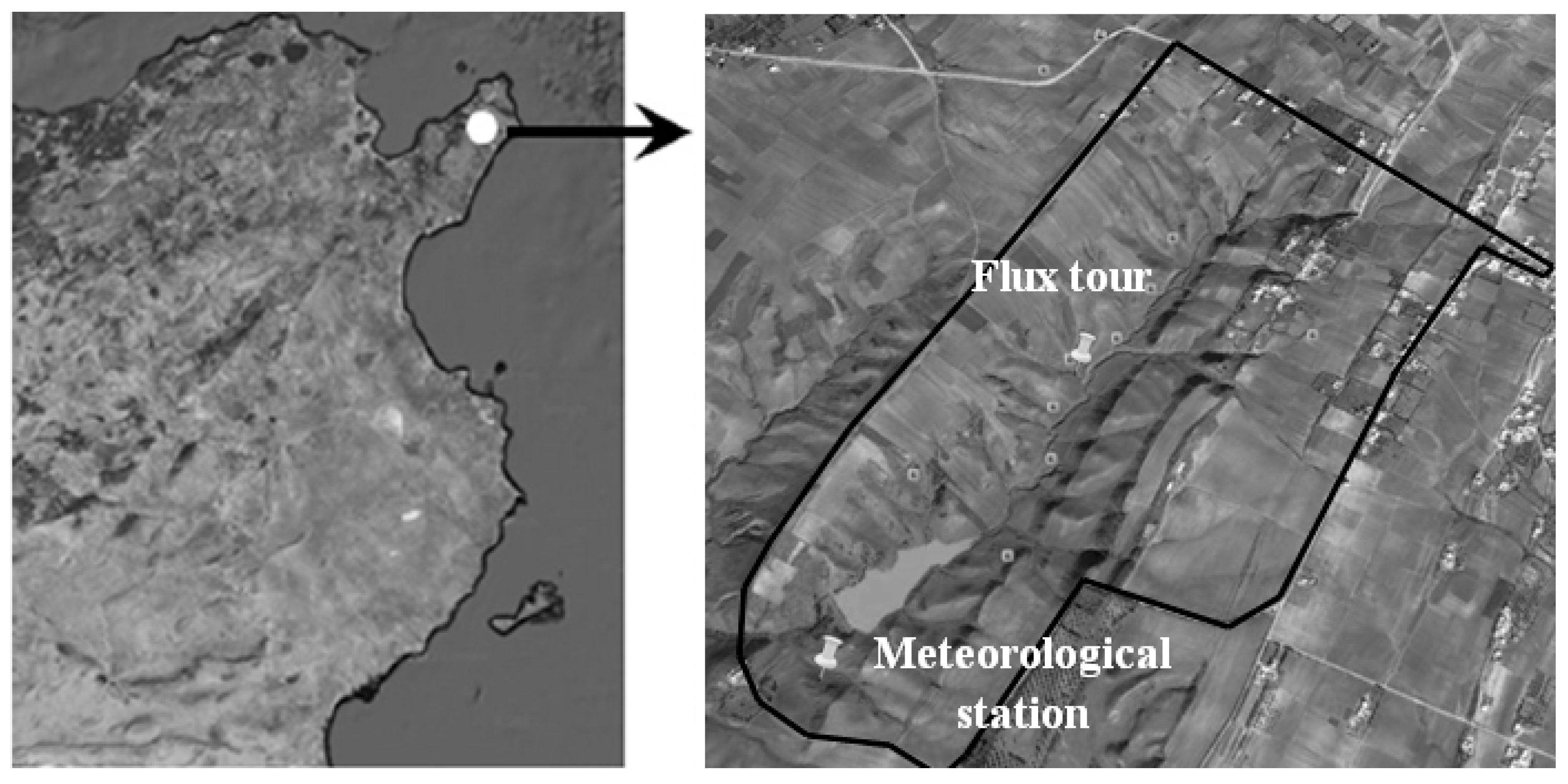
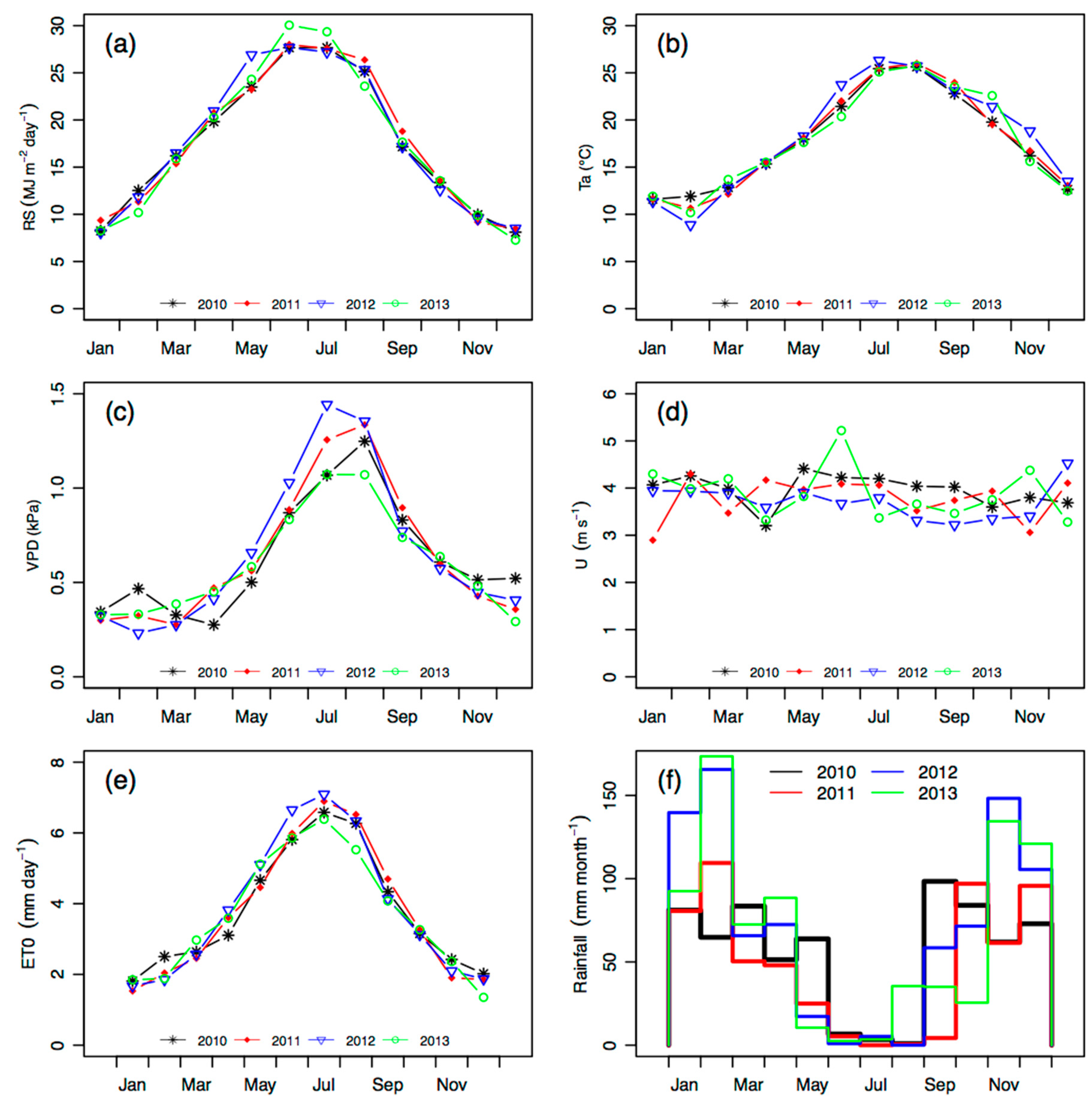
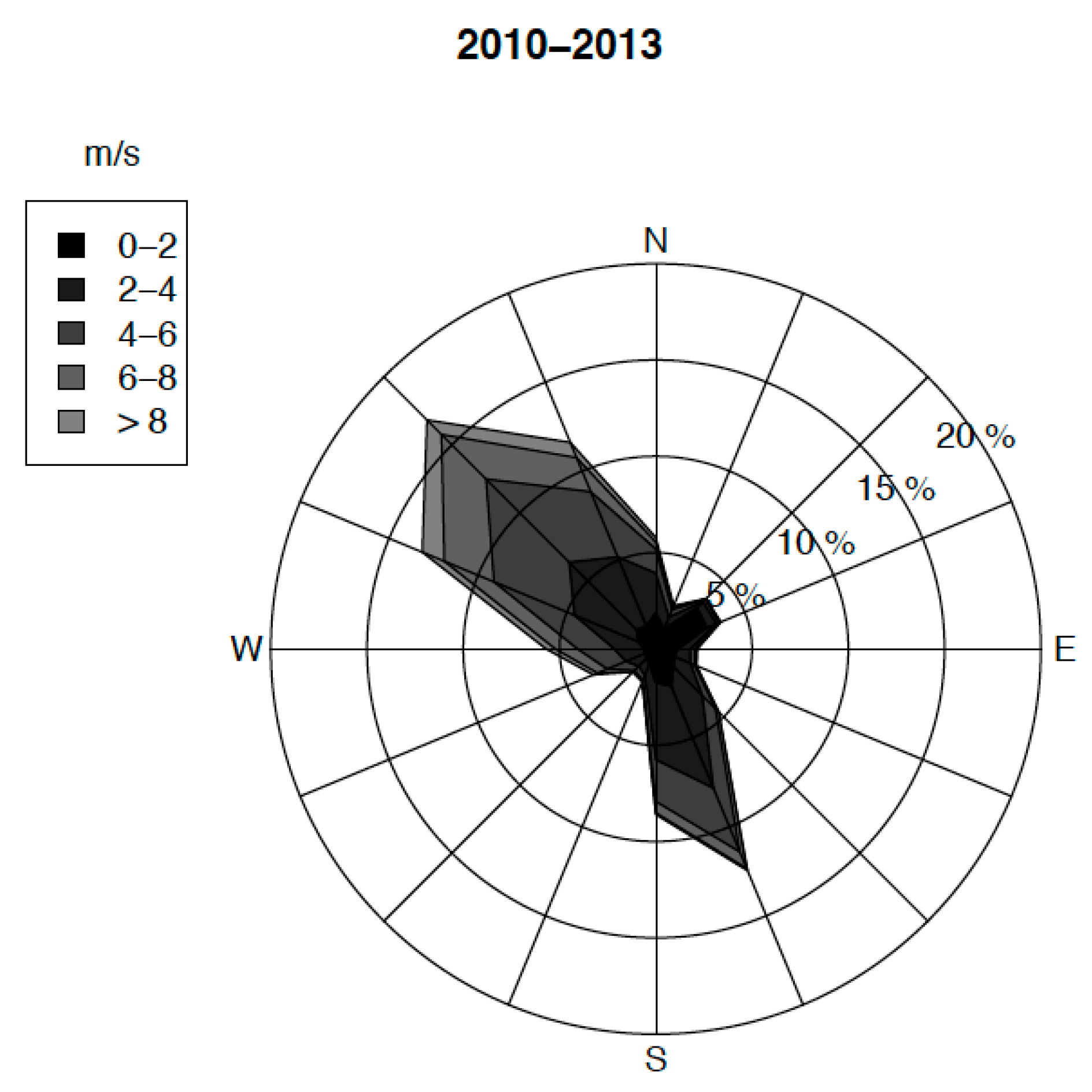
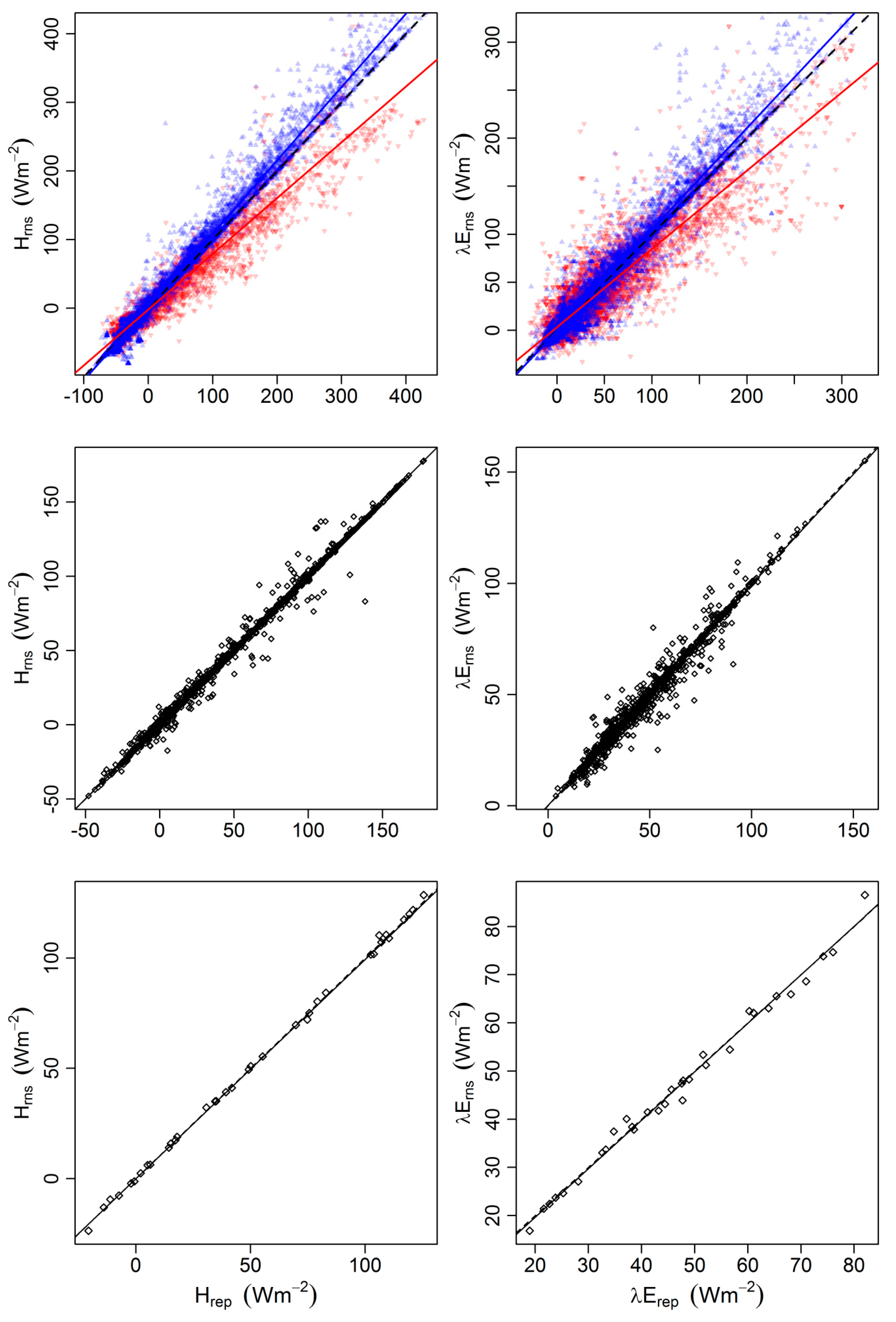
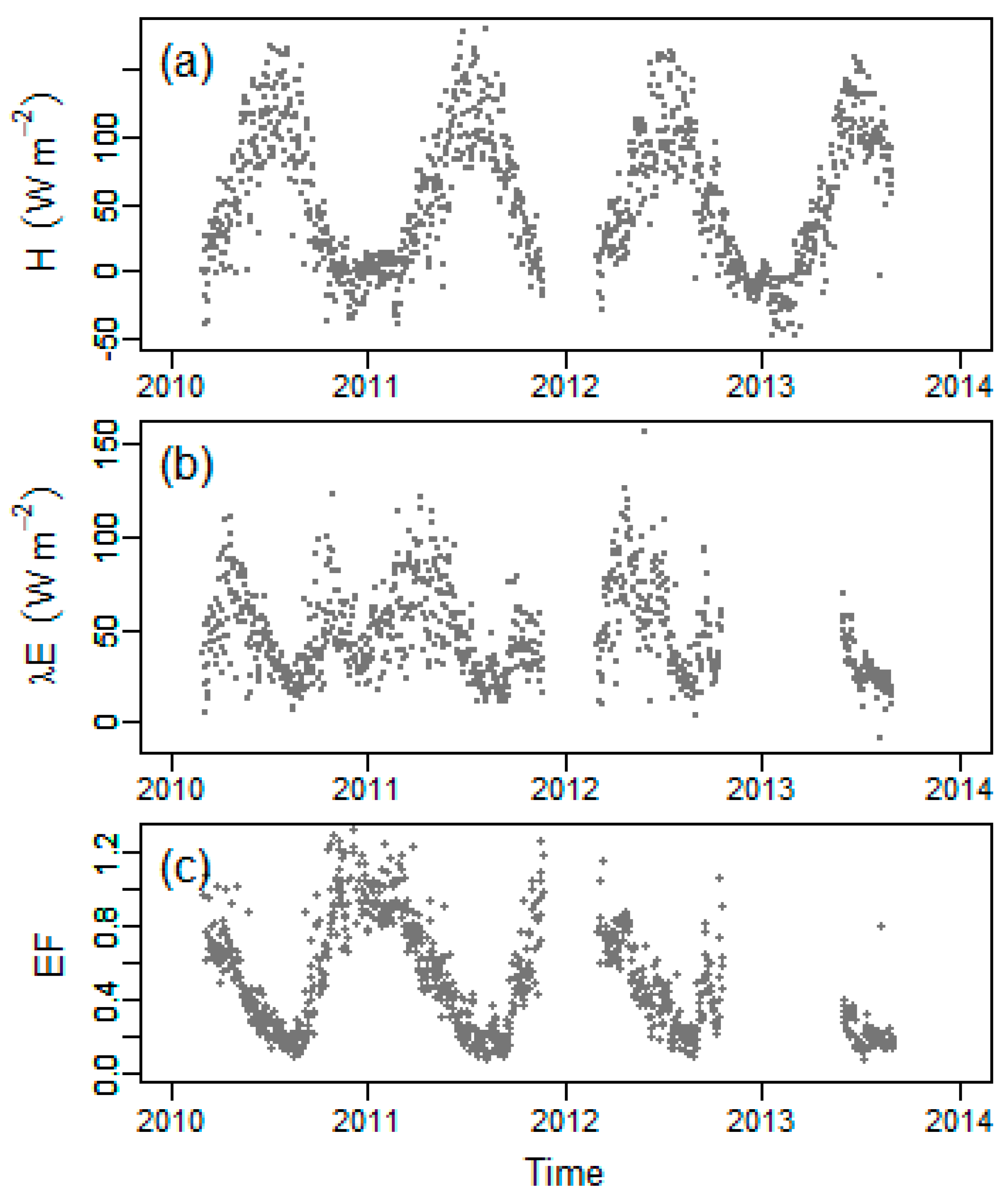
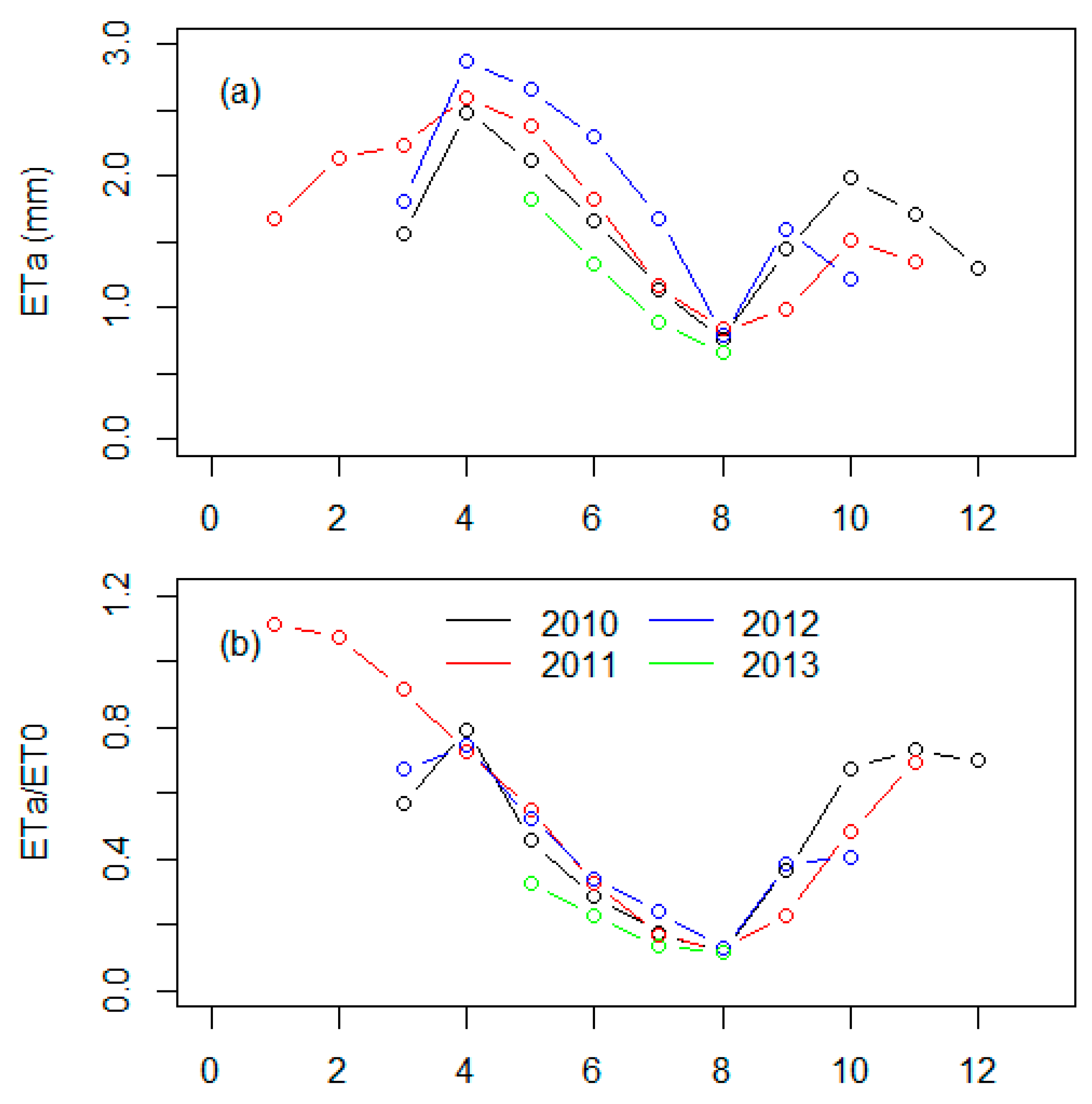
| Years | Number of Days | Number of 30-min Intervals | Missing Raw Measurements | Missing after QC | Missing after Gap-Filling REP | Missing after Gap-Filling RNS | ||||
|---|---|---|---|---|---|---|---|---|---|---|
| H | λE | H | λE | H | λE | H | λE | |||
| 2010 | 306 | 14,687 | 20% | 31% | 44% | 78% | 0% | 0% | 0% | 0% |
| 2011 | 365 | 17,520 | 25% | 28% | 48% | 66% | 11% | 11% | 11% | 11% |
| 2012 | 366 | 17,568 | 30% | 53% | 53% | 81% | 16% | 36% | 16% | 36% |
| 2013 | 243 | 11,664 | 57% | 81% | 69% | 92% | 0% | 61% | 24% | 75% |
| total | 1280 | 61,439 | 31% | 46% | 53% | 78% | 8% | 25% | 12% | 28% |
Publisher’s Note: MDPI stays neutral with regard to jurisdictional claims in published maps and institutional affiliations. |
© 2017 by the authors. Licensee MDPI, Basel, Switzerland. This article is an open access article distributed under the terms and conditions of the Creative Commons Attribution (CC BY) license (https://creativecommons.org/licenses/by/4.0/).
Share and Cite
Zitouna-Chebbi, R.; Prévot, L.; Chakhar, A.; Abdallah, M.M.-B.; Jacob, F. Observing Actual Evapotranspiration within a Hilly Watershed: Case Study of the Kamech Site, Cap Bon Peninsula, Tunisia. Proceedings 2017, 1, 113. https://doi.org/10.3390/ecas2017-04134
Zitouna-Chebbi R, Prévot L, Chakhar A, Abdallah MM-B, Jacob F. Observing Actual Evapotranspiration within a Hilly Watershed: Case Study of the Kamech Site, Cap Bon Peninsula, Tunisia. Proceedings. 2017; 1(5):113. https://doi.org/10.3390/ecas2017-04134
Chicago/Turabian StyleZitouna-Chebbi, Rim, Laurent Prévot, Amal Chakhar, Manel Marniche-Ben Abdallah, and Frederic Jacob. 2017. "Observing Actual Evapotranspiration within a Hilly Watershed: Case Study of the Kamech Site, Cap Bon Peninsula, Tunisia" Proceedings 1, no. 5: 113. https://doi.org/10.3390/ecas2017-04134
APA StyleZitouna-Chebbi, R., Prévot, L., Chakhar, A., Abdallah, M. M.-B., & Jacob, F. (2017). Observing Actual Evapotranspiration within a Hilly Watershed: Case Study of the Kamech Site, Cap Bon Peninsula, Tunisia. Proceedings, 1(5), 113. https://doi.org/10.3390/ecas2017-04134





